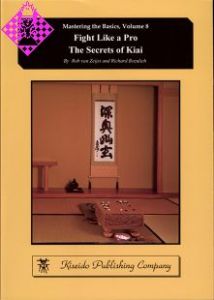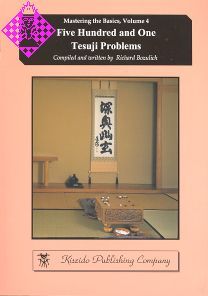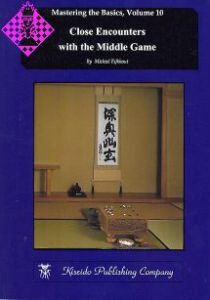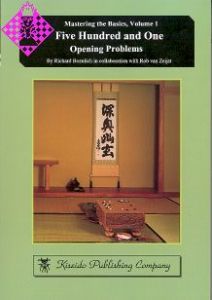Artikelnummer
LGBOZGSATO/GS01
Autor
Get Strong at the Opening
K51 - Get Strong at Go Series, Vol. 1
164 Seiten, kartoniert, Kiseido, 1996
Aus der Reihe »Get Strong at Go«
The opening is the most enjoyable part of the game to study and to play. You do not have to memorize hundreds of variation as you do in joseki or read out countless possibilities as in a life-and-death situation or in a middle-game fight. You also do not have to make precise calculations as in the endgame. This is all hard and exhausting work. In the opening, precise calculations are impossible, even for the strongest players. What is required is intuition based on good judgment. Within this constraint, you are free to use your creativity to plan your strategy.
The best way to get strong in the opening is to develop a sense of which direction to play your stones. This book, with its 175 problems, will help you accomplish this. Most of the first 90 problems are based on four of the most common opening patterns: the niren-sei, sanren-sei, the Chinese opening, and the Shusaku opening. If you seriously think about these problems and remember the key moves, you will never be at a loss as to how to play in these openings. The last 85 problems are of a more general nature and are presented in order to develop your positional sense in the opening.
The opening (fuseki) should be the foundation of all the games you play. If you come out of the opening at a disadvantage, you will have an upward struggle for the rest of the game, no matter how strong you are in the middle-game fighting and in the endgame. This is why professional players usually spend such an extraordinary amount of their allotted time thinking about the first 20 or so moves. Even for them, the opening is the most difficult part of the game to understand. There are so many possible good moves, and no one can say that a certain move is better than another. Unlike the endgame, life-and-death situations, and tesujis, where the result can often be precisely determined, results in the opening are often ambiguous.
Still, the opening is the most enjoyable part of the game to study and to play. You do not have to memorize hundreds of variation as you do in josekis or read out countless possibilities as in a life-and-death situation or in a middle-game fight. You also do not have to make precise calculations as in the endgame. This is all hard and exhausting work. In the opening, precise calculations are impossible, even for the strongest players; what is required is intuition based on good judgment. Within this constraint, you are free to use your creativity to plan your strategy.
The best way to get strong in the opening is to develop a sense of which direction to play your stones. This book, with its 175 problems, will help you accomplish this goal. Most of the first 90 problems are based on four of the most common opening patterns: the niren-sei, sanren-sei, the Chinese opening, and the Shusaku opening. If you seriously think about these problems and remember the key moves, you will never be at a loss as to how to play in these openings. The last 85 problems are of a more general nature and are presented in order to develop your positional sense in the opening.
When studying this book, it is not important for you get the correct answer to the problems. More important is that you think about the problem, come up with an answer, then compare the correct answer to your answer. The answers are usually only a few moves long, so you do not have to struggle over long and complicated variations. Hence, even if you are only a 20-kyu player, you will be able gain a lot from these problems, and it will also prepare you for the more difficult three volumes on joseki (volumes 2 to 4 of this series).
Finally, I would like to thank the Nihon Ki-in for allowing me to use the problems in this book, all of which were taken from their publications.
Richard Bozulich, preface
The best way to get strong in the opening is to develop a sense of which direction to play your stones. This book, with its 175 problems, will help you accomplish this. Most of the first 90 problems are based on four of the most common opening patterns: the niren-sei, sanren-sei, the Chinese opening, and the Shusaku opening. If you seriously think about these problems and remember the key moves, you will never be at a loss as to how to play in these openings. The last 85 problems are of a more general nature and are presented in order to develop your positional sense in the opening.
The opening (fuseki) should be the foundation of all the games you play. If you come out of the opening at a disadvantage, you will have an upward struggle for the rest of the game, no matter how strong you are in the middle-game fighting and in the endgame. This is why professional players usually spend such an extraordinary amount of their allotted time thinking about the first 20 or so moves. Even for them, the opening is the most difficult part of the game to understand. There are so many possible good moves, and no one can say that a certain move is better than another. Unlike the endgame, life-and-death situations, and tesujis, where the result can often be precisely determined, results in the opening are often ambiguous.
Still, the opening is the most enjoyable part of the game to study and to play. You do not have to memorize hundreds of variation as you do in josekis or read out countless possibilities as in a life-and-death situation or in a middle-game fight. You also do not have to make precise calculations as in the endgame. This is all hard and exhausting work. In the opening, precise calculations are impossible, even for the strongest players; what is required is intuition based on good judgment. Within this constraint, you are free to use your creativity to plan your strategy.
The best way to get strong in the opening is to develop a sense of which direction to play your stones. This book, with its 175 problems, will help you accomplish this goal. Most of the first 90 problems are based on four of the most common opening patterns: the niren-sei, sanren-sei, the Chinese opening, and the Shusaku opening. If you seriously think about these problems and remember the key moves, you will never be at a loss as to how to play in these openings. The last 85 problems are of a more general nature and are presented in order to develop your positional sense in the opening.
When studying this book, it is not important for you get the correct answer to the problems. More important is that you think about the problem, come up with an answer, then compare the correct answer to your answer. The answers are usually only a few moves long, so you do not have to struggle over long and complicated variations. Hence, even if you are only a 20-kyu player, you will be able gain a lot from these problems, and it will also prepare you for the more difficult three volumes on joseki (volumes 2 to 4 of this series).
Finally, I would like to thank the Nihon Ki-in for allowing me to use the problems in this book, all of which were taken from their publications.
Richard Bozulich, preface
| EAN | 9784906574513 |
|---|---|
| Gewicht | 230 g |
| Hersteller | Kiseido |
| Breite | 15 cm |
| Höhe | 21 cm |
| Medium | Buch |
| Erscheinungsjahr | 1996 |
| Autor | Richard Bozulich |
| Reihe | Get Strong at Go |
| Sprache | Englisch |
| ISBN-10 | 4906574513 |
| ISBN-13 | 978-4906574513 |
| Seiten | 164 |
| Einband | kartoniert |
| Name | Kiseido Publishing Company |
|---|
iv Preface
v Some Important Terms and Concepts
001 Introduction
003-164 Fuseki Problems
v Some Important Terms and Concepts
001 Introduction
003-164 Fuseki Problems
Mehr von Kiseido
-
 Fuseki Revolution24,95 €
Fuseki Revolution24,95 € -
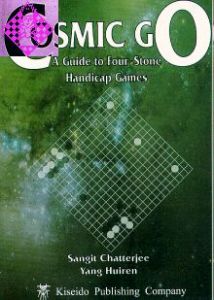 Cosmic Go19,50 €
Cosmic Go19,50 € -
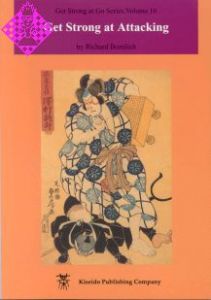 Get Strong at Attacking19,50 €
Get Strong at Attacking19,50 € - Mehr von Kiseido


